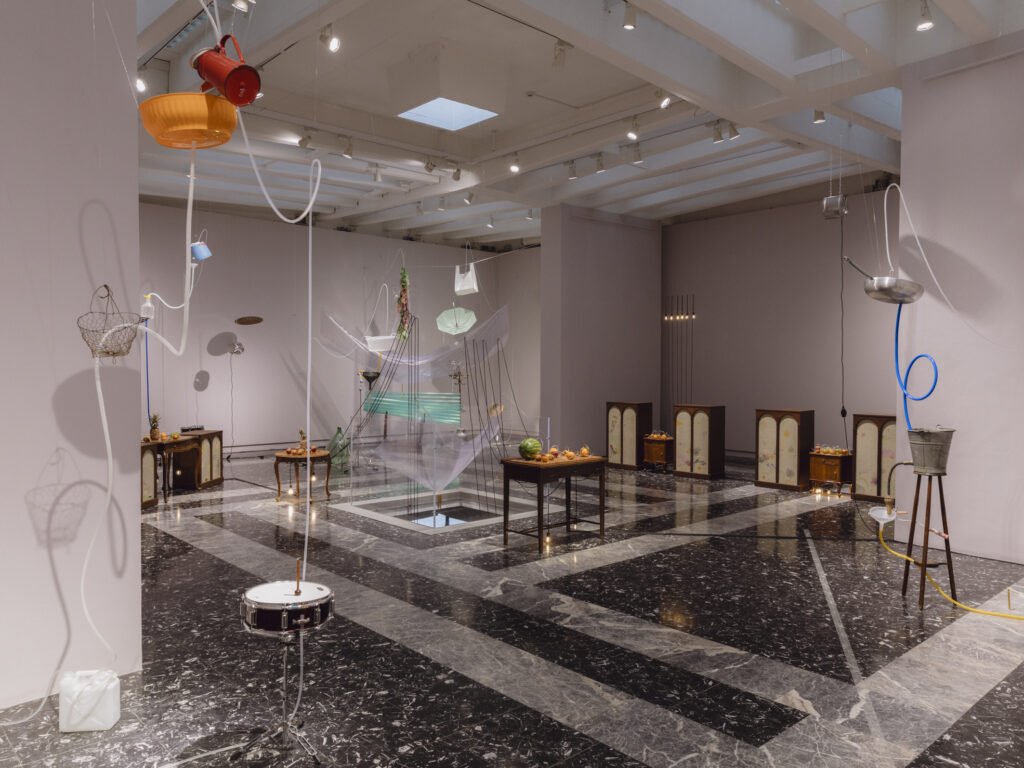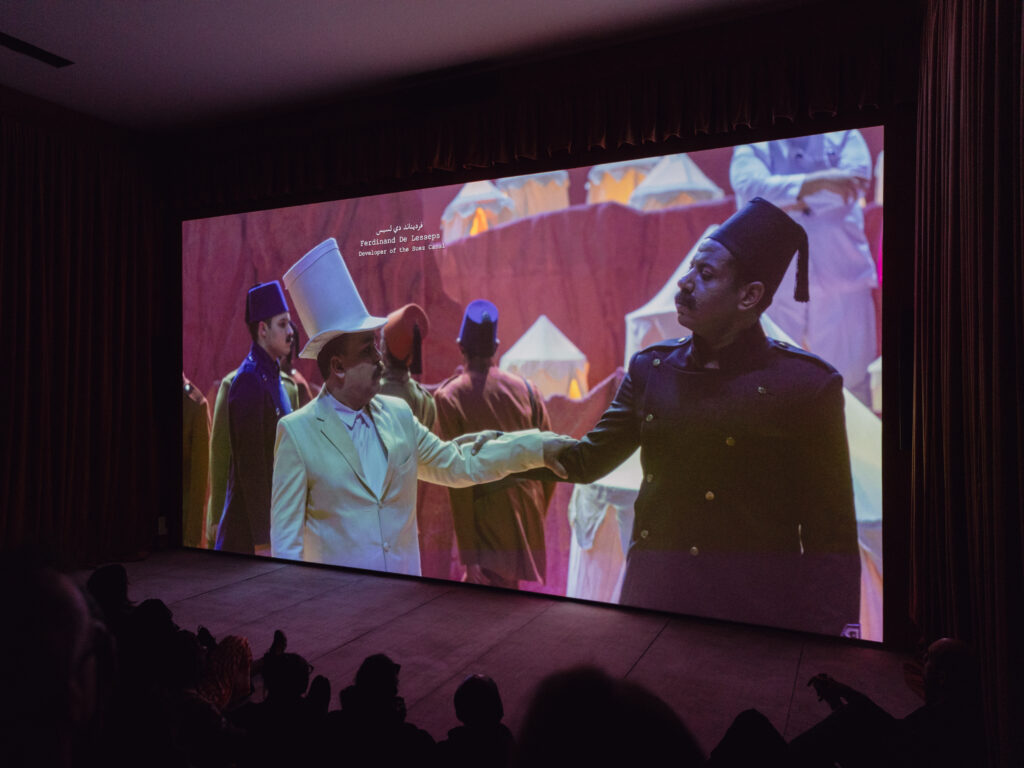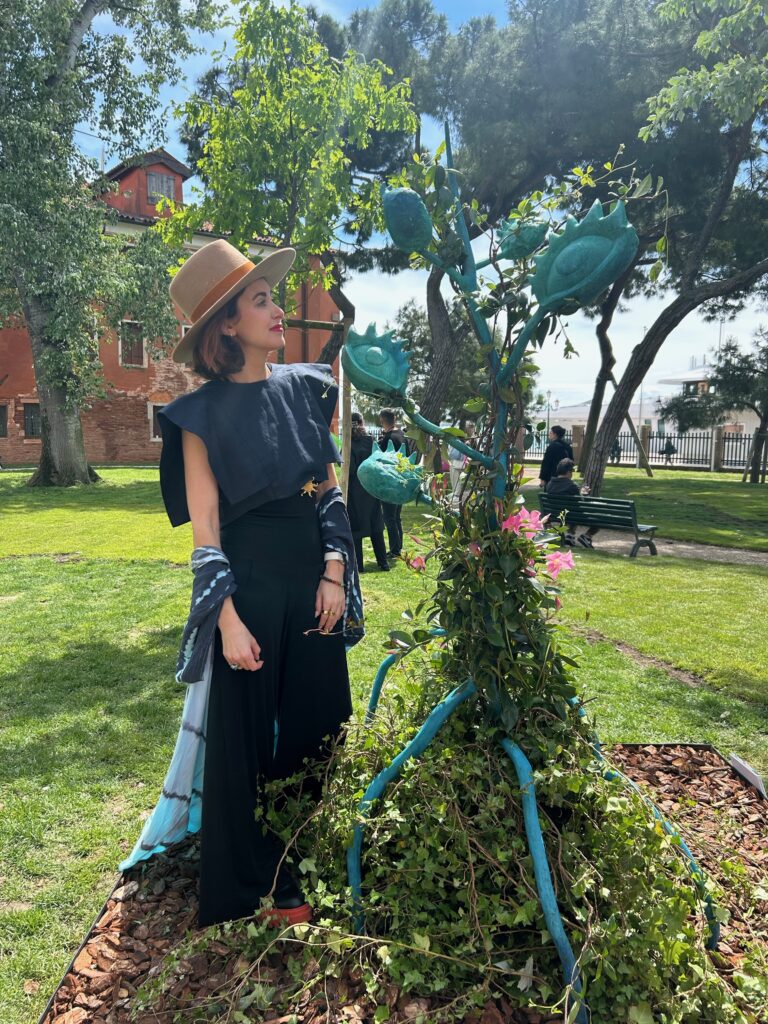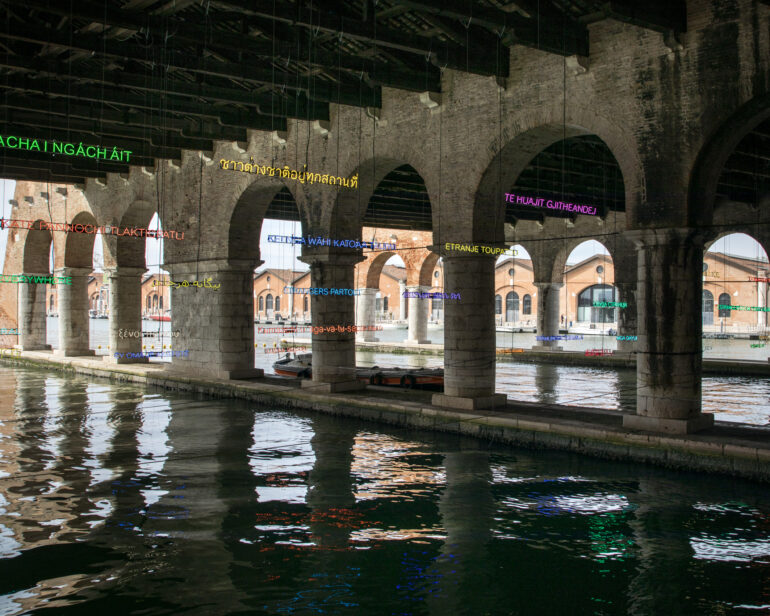Stranieri Ovunque (Foreigners Everywhere) is Curator Adriano Pedrosa’s theme for the 60th International Exhibition of La Biennale di Venezia. Stranieri Ovunque is inspired by a series of works made by Palermo-based art collective Claire Fontaine since 2004, which consist of neon sculptures spelling out the words in more than 50 different languages, including indigenous languages, which are displayed throughout the Biennale central exhibitions at the Arsenale and Giardini. Claire Fontaine originally appropriated the phrase Stranieri Ovunque from a collective in Turin who fought racism and xenophobia in Italy in the early 2000s.
Stranieri Ovunque is a polarising title for the Biennale Arte as it could be perceived as a Xenophobic phrase which plays into a far-right sensibility. Artist Anish Kapoor has been quoted as saying that the phrase plays into the hands of anti-immigrant sentiment in Italy rather than opposing it, and he asked the organisers to consider changing the name. Controversially, the new President of Biennale is Pietrangelo Buttafuoco, a right-leaning columnist and writer who was a member of a neo-facist organisation as a youth. Curator Adriano Perosa maintains the duality of the phrase, and sets out with his curation to focus on indigenous, immigrant, marginalised and Queer artists, in a mission to emphasise that we are all foreigners in some sense.
“Artists have always travelled and moved about through cities, countries and continents. The Biennale Arte 2024’s primary focus is thus artists who are themselves foreigners, immigrants, expatriates, diasporic, emigres, exiled, or refugees.” Adriano Perosa
A world bursting with crises relating to migration or displacement of peoples resulting from war, environmental disasters, religious or gender-based discrimination and poverty is the uncomfortable background for the 2024 Biennale’s theme.
In the central exhibitions of the Biennale Arte there is an emphasis on artists from the global South and indigenous art, and indigenous Artists Archie Moore and the Mataaho Collective were awarded Venice’s Golden Lions, with Moore winning best national pavilion for Australia (the country’s first Gold Lion). Moore spent months coating the exterior of the Pavilion with blackboard paint then applying chalk drawings to trace relationships between people and place back for 65,000 years. He references Australia’s cultural heritage, erased histories and the first nation people of Australia who are one of the oldest living cultures.

The Central Stranieri Ovunque exhibitions spread over two vast sites – the Giardini, where there are around 30 National Pavilions, and the Arsenale, a former ship-building yard. There are around 300 artists exhibiting in the central exhibitions with 88 National Participations. Major museum exhibitions and official collateral events as well as vanity projects of collectors and galleries are dotted around the city.
Although the national pavilions of the Biennale don’t have to adhere to the central theme and have autonomy to select an artist to represent their country, there is an overwhelming sense that most countries are presenting artists whose work responds to the Stranieri Ovunque theme. Indigenous artists are representing USA, Brazil, Denmark and Australia, while diasporic artists or artists from countries that have been colonized are representing some countries, with Spain represented by an artist from Peru and the Dutch Pavilion exhibiting the work of a collective from the Congo, perhaps in a gesture of reparation for Colonization.
The 2024 Venice Biennale is at times a political one, with many Pavilions referencing war, colonization, discrimination or displacement. Ruth Patir, the artist representing Israel, refused to open the Pavilion during the Vernissage days, putting a sign in the window declaring it won’t open until there is a ceasefire between Gaza and Israel, although her video work ‘(M)otherland’ is visible through the glass. Olena Zelenska, First Lady of Ukraine, gave a moving video address at the opening of the Ukraine Pavilion, emphasising the importance of art in preserving values of humanity: “Art will not save us from bombs and bullets. But it will save our conscience, our humanity, and our values. I invite you to the Ukrainian Pavilion to weave nets of understanding, support, and protection of life with us.”
Here are Culturalee’s higlights from the Giardini, Arsenale and Collateral exhibitions.
USA Pavilion: Jeffrey Gibson The space in which to place me
Curated by Kathleen Ash-Milby, Abigail Winograd, the USA Pavilion in the Giardini is dedicated to the breathtaking art of Jeffrey Gibson, a member of the Mississippi Band of Choctaw Indians and of Cherokee descent. Multi-disciplinary artist Gibson has created a truly joyful and immersive experience that commences before entering the USA Pavilion, by enveloping it’s classical façade with his rainbow coloured, geometric designs, and uplifting mantras. Inside the Pavilion is infused with more colour and joy, with intricately beaded and costumed figures inspired by indigenous American tribal aesthetics, and paintings featuring Gibson’s signature geometrical shapes and unique rainbow-coloured font. His mantras include phrases such as ‘If not now then when’, ‘Give my life something extra’ and ‘If you want to lift yourself up, lift up someone else.’ While he references civil injustices against minorities and indigenous American people such as the 1970-71 enforcement acts, his message is one of hope for a more equal and humane society in the future.
He visualises “a space in which Indigenous art and a broad spectrum of cultural expressions and identities are central to the American experience.”
Gibson has created an interdisciplinary practice and hybrid visual vocabulary by drawing on American, Indigenous, and queer histories, with references to popular subcultures, literature, and global artistic traditions. His artistic practice reflects the vibrant realities of Indigenous communities in the United States, a form of cultural critique that engages with complex histories rather than erasing them.
https://www.labiennale.org/en/united-states-america

Great Britain Pavilion: John Akomfrah Listening all Night to the Rain
Listening all Night to the Rain, the British Pavilion curated by Tarini Malik in the Giardini, is dedicated to artist and filmmaker John Akomfrah, who fills the 19th Century Neo-classical building with a multiscreen investigation into climate change, racial injustice, and the experiences of migrant diasporas in Britain.
Listening All Night To the Rain takes its title from the poetry of 11th century Chinese writer and artist Su Dongpo’s, which explored the transitory nature of life during a period of political exile. The exhibition is organised into a series of song-like movements or ‘cantos’ and unites eight interlocking and overlapping multimedia and sound installations into a single and immersive environment. Listening All Night To the is the result of decades of extensive research by the artist and his team, using historical records to contextualise our experience of the present day. The exhibition continues Akomfrah’s preoccupation with themes of post-colonialism, ecology and the politics of aesthetics with a renewed focus on the act of listening and the sonic.
https://www.labiennale.org/en/art/2024/great-britain

Japan Pavilion: Yuko Mohri Compose.
Yuko Mohri Compose is curated by Sook-Kyung Lee for the Japanese Pavilion in the Giardini. Mohri is known for her installations and sculptures centred on “events” that change with conditions such as their environment, and she fills the pavilion with sound, light, movement, and smell. Mohri was inspired by ad hoc efforts seen in Tokyo subway stations to stop water leaks, and Moré Moré ( meaning ‘Leaky’) artificially creates leaks and attempts to fix them, improvising with a variety of household goods available in Venice to construct kinetic sculpture. The exhibition is Mohri’s comment on the devastating effects of global warming and consequent floods affecting the environment. Moré Moré is especially significant in Venice, a city hit by a flood once every fifty years and in danger of sinking forever at some point in the future.
With a title that etymologically signifies “to place together (com+pose)”, the exhibition asks what it means for people to be and work together in a world facing multiple global crises. Paradoxically, the crisis brings out the greatest creativity — inspired by the subway workers’ resourceful measures against water leak.
https://www.labiennale.org/en/art/2024/japan

Egypt Pavilion: Wael Shawky Drama 1882
Alexandria-Born artist Wael Shawky’s musical film ‘Drama 1882’ was a huge hit during the Vernissage days, with vast queues forming outside the Egyptian Pavilion. Shawky composed and staged a live action opera based on Egypt’s Nationalist Urabi revolution (1879–82) against Imperial rule, which started with a fight in a café which erupted into riots, and ended with British forces bombarding Alexandria and the Battle of Tel El Kebir when the British proceeded to occupy the country. Drama 1882 was filmed in Alexandria in a historic open-air theatre in Alexandria and sung in classical Arabic. Shawky shows a recording of the opera alongside sculptural elements from the film’s sets and uses performance, sculpture, drawing and film to examine common notions of national and religious identity by recasting established viewpoints of history.
labiennale.org/en/art/2024/egypt

GLASSTRESS 8 ½ at Fondazione Berengo, Murano
Fondazione Berengo and Berengo Studio have an amazing lineup of artists for the 2024 edition of their biannual exhibition Glasstress, including Wael Shawky who is representing Egypt in the Biennale Arte, as well as Ai Weiwei, Chila Kumari Burman, Laure Prouvost, Ryan Gander, Tony Cragg, Nathalie Djurberg and Hans Berg. Many of the 30 exhibiting artists are working with the material of glass for the first time, and have collaborated with the glass masters of Berengo Studio for the 8th edition of GLASSTRESS.
GLASSTRESS 8 ½ takes place in a historic furnace on the enchanting island of Murano, which was transformed into an exhibition space in 2009, while there is a parallel special project at the Tesa 99 in the Arsenale Nord.
Curated by Umberto Croppi, GLASSTRESS 8 ½ takes its title from Federico Fellini’s cinematic masterpiece, a film inspired by magic of artistic creation, and is also a nod to the exhibition’s 8th edition.
GLASSTRESS 8 1/2 is presented by Fondazione Berengo and Berengo Studio at
Tesa 99, Arsenale and Fondazione Berengo, Murano until 24th November, 2024.

European Cultural Centre ‘Personal Structures’
The 7th edition of the European Cultural Centre’s biennial contemporary art exhibition Personal Structuresencourages exploration beyond boundaries, fostering a broader perspective, and overcoming restrictions to promote personal, social, and global growth. The exhibition is spread over the ECC’s historical venues of Palazzo Bembo and Palazzo Mora, and there is an enchanting sculpture exhibition in the Marinaressa Gardens not far from the Giardini. Lauren Baker is exhibiting ‘Consciousness Awakening’ in the gardens, a surreal sculpture incorporating multiple eyes sprouting from a plant.
“Consciousness Awakening serves as a poignant reflection on the theme of “Foreigners Everywhere” during the Venice Biennale. Rooted in a profound connection to nature, the sculpture explores the unfamiliarity inherent in our relationship with the natural world. The inclusion of watchful eyes within the sculpture symbolizes a universal language of observation, transcending barriers of language and nationality. In this context, the concept of “foreignness” takes on new meaning, inviting viewers to reconsider their perceptions of what is familiar and what is foreign in the natural realm.” Lauren Baker
Until 24th November 2024 at the Marinaressa Gardens.
https://personalstructures.com

The Biennale Arte takes place in Venice until 24th November, 2024.



